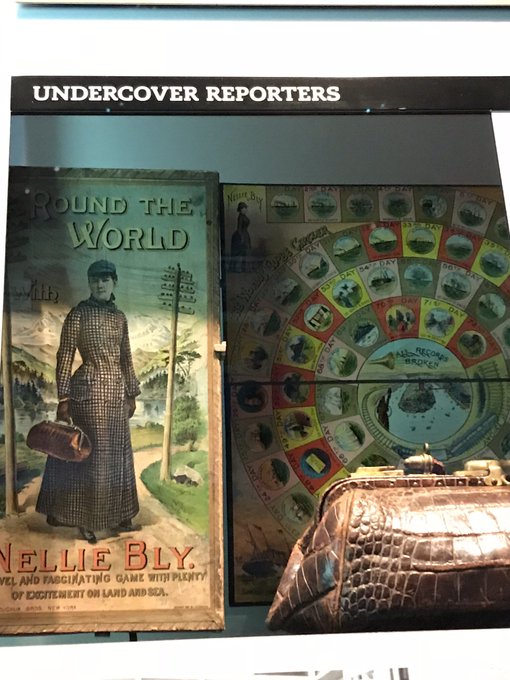
Lifetime - Screenshot of Trailer Nellie Bly is one of the first investigative journalists in American history, and is known for willingly admitting herself to a mental hospital to expose the abusive conditions.
Nellie Bly, whose real name is Elizabeth Cochrane Seaman, is considered one of the first investigative journalists in American history. Bly feigned mental illness to gain access to a notorious New York mental hospital, in an attempt to expose how patients were being treated.
In 1889, she made a famous, widely reported and intrepid 72-day trip around the globe, just one of many feats by this amazing woman. The Lifetime movie “Escaping the Madhouse: The Nellie Bly Story” is based on Bly’s life, and stars Christina Ricci.
The synopsis of the movie reads: “On a mission to expose the deplorable conditions and mistreatment of patients at the notorious Women’s Lunatic Asylum, investigative reporter Nellie Bly (Christina Ricci) feigns mental illness in order to be institutionalized to report from the inside. The movie delivers an intense and fictionalized account of actual events surrounding Nellie’s stay beginning after Nellie has undergone treatment, leaving her with no recollection of how she came to the asylum or her real identity. Nellie’s unwillingness to submit to authority results in unspeakable torture at the hands of the head nurse, Matron Grady (Judith Light). When Nellie captures the attention of Dr. Josiah (Josh Bowman) who tries to help her, Grady’s barbaric tactics only intensify, leading Nellie to questions if she actually does belong in the asylum after all.”
Here’s what we know about Bly’s life:
1. Bly is Considered One of The Very First Investigative Journalists in American History
After dropping out of school to help her mother run a boardinghouse, Bly penned an open letter to the Pittsburgh Dispatch, pointing out the paper’s negative representation of women, according to Women’s History. The editor of the Pittsburgh Dispatch was so impressed by her piece that he printed her letter and offered her a job as a columnist, which is when she took on the pen name Nellie Bly.
Despite being a popular columnist, she was often forced to write pieces that only pertained to women. Wanting to branch out and write about issues that mattered to both men and women, she began looking for another job, which brought her to New York City. There, she sought out a publication that would publish a story on the immigrant experience in the United States, and although the editor of New York World declined her story, he challenged her to investigate a notorious mental hospital in the city. Bly accepted and took her challenge one step further by admitting herself to the hospital as an undercover patient to really expose how patients were treated by the hospital staff, leading her to become one of the first investigative journalists in American history.
2. She Committed Herself to The Mental Hospital to Expose Abuse & Neglect in The Famous New York Institute
After checking herself into a women’s home, she began questioning the women who seemed most “insane” to her. It didn’t take long for Bly to be deemed crazy, and the matron of the house she was staying in had her escorted to the Essex Market Police Courtroom, where a judge pronounced her insane and sent her to Bellevue Hospital. She boarded a ferry to Blackwell’s Island and was told by an ambulance driver that she was on her way to a hospital that she’d “never get out of.”
During her time at the hospital, she took notes of both her own experiences and those of her fellow patients, noting that only 16 doctors were in charge of some 1,600 patients. “Excepting two,” she recorded, “I have never seen them pay any attention to the patients.” According to Women’s History, she also “questioned the judge’s ability to pronounce a woman insane ‘by merely bidding her good morning and refusing to hear her pleas of release? Even the sick ones know it is useless to say anything for the answer will be that it is their imagination.'”
Her reporting also included the high rate of cultural insensitivity to immigrant women who spoke very little or no English, and a plethora of abusive treatments, including mandatory ice cold baths and confinement in cramped, vermin-infested, locked rooms.
3. She Was Only Released From The Mental Hospital After Her Employer Sent an Attorney to Release Her & New York City Municipal Government Officials Began Looking Into The Abuse & Neglect Bly Reported
After a few days on Blackwell’s Island, Bly tried to drop her act as mentally ill and attempted to secure her release, but was unable to convince the hospital to let her go. She was only released after her employer, New York World, sent an attorney to arrange for her release. Two days after she was free, New York World ran the first installment of her report, titled “Behind Asylum Bars,” and Bly quickly rose to journalistic fame, according to PBS.
Following the publication of her story, the New York City municipal government began an investigation of the abuse reported by Bly, and started allocating more money for the care of the mentally ill on Blackwell’s Island. According to PBS, approximately one month after her story ran, Blackwell Island’s treatment of patients and the living conditions of the facility improved substantially. More nourishing meals were provided, translators were hired for those with language barriers, and better sanitation was implemented. To top it off, the most abusive nurses and physicians were fired and replaced.
4. When She Took Her Trip Around The Globe, She Didn’t Realize She Was Competing Against a Journalist From a Rival Publication
Aside from her success as a journalist, Bly is probably best known for her incredible 72-day trip around the world in 1889. She under took her voyage, mainly by steamship and train, unknowingly competing against a reporter from a rival publication, according to Smithsonian Mag.
Bly’s goal was to beat the fictional Phileas Fogg’s 80-day odyssey, as written in the 1873 novel by Jules Verne, but her “courage and determination helped her circumnavigate the globe in just 72 days, setting a world record, besting her own goal of 75 days and—unbeknownst to her—beating out her competitor, Elizabeth Bisland of Cosmopolitan magazine,” Smithsonian Mag reports.
Her editor at New York World initially resisted sending her, claiming her gender would make the trip impossible. “No one but a man can do this,” he told her. “Very well,” she replied, “Start the man, and I’ll start the same day for some other newspaper and beat him.” He eventually conceded, according to Smithsonian Mag.
5. Bly Married a Millionaire in 1895 & Patented Many Inventions Related to Oil Manufacturing
In the late 1980’s, Bly married millionaire Robert Seamen and retried from journalism. Her husband died in 1903, leaving her in charge of an enormous manufacturing company, which sparked an interest in business and manufacturing in Bly.
She went on to patent several inventions related to oil manufacturing, many of which are still used today, according to Women’s History. She eventually returned to journalism, covering the women’s suffrage movement and the first World War. Sadly, Bly passed away after battling pneumonia on January 27, 1922.
READ NEXT: Church of Scientology’s Secretive ‘Gold Base’ Headquarters: PHOTOS





